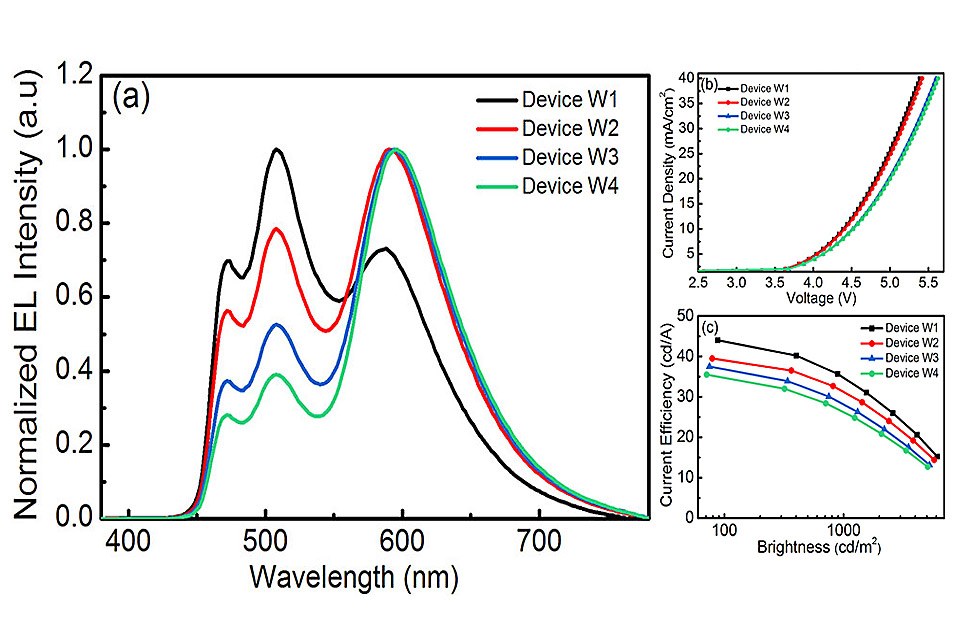Research on OLEDs with Ultrathin Emissive Layers and a Spacer-Free Structure
Since C.W Tang demonstrated the first organic light-emitting diodes (OLEDs) based on a double-layer structure of organic materials in 1987, flat-panel displays and lighting applications based on OLED technology have grown dramatically because of their attractive features such as ultra-thin structure, light-weight and flexibility. To achieve a desirable OLED performance, a host-dopant system is adopted. This not only leads to an increase in material cost and device processing time, but also makes it difficult to control dopant concentration accurately. Therefore, OLEDs with dopant-free and ultrathin emissive layers (UEMLs) have aroused much attention. Shengfan Wu, Sihua Li, Qi Sun, Chenchao Huang & Man-Keung Fung recently published the results of their research on such ultrathin emissive layers (UEMLs) of phosphorescent materials for OLED applications.
Abstract:
Ultrathin emissive layers (UEMLs) of phosphorescent materials with a layer thickness of less than 0.3 nm were introduced for high-efficiency organic light-emitting diodes (OLEDs). All the UEMLs for white OLEDs can be prepared without the use of interlayers or spacers. Compared with devices fabricated with interlayers inserted in-between the UEMLs, our spacer-free structure not only significantly improves device efficiency, but also simplifies the fabrication process, thus it has a great potential in lowering the cost of OLED panels. In addition, its spacer-free structure decreases the number of interfaces which often introduce unnecessary energy barriers in these devices. In the present work, UEMLs of red, green and blue-emitting phosphorescent materials and yellow and blue phosphorescent emitters are utilized for the demonstration of spacer-free white OLEDs. Upon optimization of the device structure, we demonstrated spacer-free and simple-structured white-emitting OLEDs with a good device performance. The current and power efficiencies of our white-emitting devices are as high as 56.0 cd/A and 55.5 lm/W, respectively. These efficiencies are the highest ever reported for OLEDs fabricated with the UEML approach.
Approach:
In their paper, the autors first discuss high-efficiency red, green and blue-emitting OLEDs based on phosphorescent UEMLs, the efficiencies of which are comparable or even better than those fabricated using conventional host-guest systems. Simple and high-efficiency white OLEDs were also fabricated using phosphorescent UEMLs consisting of red, green and blue emitters as well as orange and blue emitting materials, without any interlayer. The color balance was actively tuned by the thickness of the UEMLs in a much simpler and more controllable way. Therefore, UEMLs with spacer-free structures have a great potential in achieving power-efficient white OLEDs.
In order to express the promising potential of UEMLs, several green-emitting phosphorescent OLEDs (PHOLEDs) with different conventional host-guest systems were fabricated for comparison. It is remarkable that the performance of green OLED prepared by the UEML approach surpasses those fabricated by the conventional host-guest systems.
In view of the above remarkable results, two-color PHOLEDs based on green and blue UEMLs were fabricated. For those multi-color OLEDs currently prepared with the UEML approach, an interlayer is usually inserted in between two emissive layers. It can be speculated that the second UEML may fill the unoccupied sites randomly as an interstitial doping. Therefore, interlayer or spacer may not be necessary in multi-color UEML based devices. Consequently, simple and spacer-free UEML-based OLED devices were fabricated. Once the thickness of the phosphorescent UMELs has been optimized, three-color white OLEDs based on red, green and blue UEMLs were explored.
Conclusion:
UEML based OLEDs show an excellent device performance. The red, green and blue OLEDs with UEML structures exhibit a current efficiency of 29.9 cd/A, 79.5 cd/A and 39.0 cd/A, respectively, which are comparable or even better than conventional OLEDs which use host-guest system. High-efficiency UEML based two-color and three-color white OLEDs have also been fabricated. It has been successfully demonstrated that interlayers or spacers are not needed, and the device structures of white OLEDs are significantly simplified. For three-color white OLEDs, current and power efficiencies of 39.5 cd/A and 38.9 lm/W could be obtained with CIE (x, y) of (0.43, 0.44). If the white OLED has a warmer emission (two-color white), the current and power efficiencies could be increased to 56.0 cd/A and 55.5 lm/W, respectively. The device efficiencies of our two-color and three-color white OLEDs demonstrated here are so far the highest ever reported for devices with ultrathin emitting-layer structures. Therefore, OLEDs fabricated with UEMLs are very cost-effective and promising.
References:
This article is a short summary of the original paper.
The original paper is published at http://www.nature.com/articles/srep25821
Author information:
Institute of Functional Nano & Soft Materials (FUNSOM), Jiangsu Key Laboratory for Carbon-Based Functional Materials & Devices, Soochow University, 199 Ren’ai Road, Suzhou, 215123, Jiangsu, PR China
Shengfan Wu, Sihua Li, Qi Sun, Chenchao Huang & Man-Keung Fung
S.W. conceived the idea and designed the experiments. S.L. fabricated the devices and measured the device performance. Q.S. and C.H. participated in structure designing. M.F. analyzed most of the data and revised the manuscript. All authors reviewed the manuscript and contributed to this work.
License Information:
![]() This work is licensed under a Creative Commons Attribution 4.0 International License. The images or other third party material in this article are included in the article’s Creative Commons license, unless indicated otherwise in the credit line; if the material is not included under the Creative Commons license, users will need to obtain permission from the license holder to reproduce the material. To view a copy of this license, visit http://creativecommons.org/licenses/by/4.0/
This work is licensed under a Creative Commons Attribution 4.0 International License. The images or other third party material in this article are included in the article’s Creative Commons license, unless indicated otherwise in the credit line; if the material is not included under the Creative Commons license, users will need to obtain permission from the license holder to reproduce the material. To view a copy of this license, visit http://creativecommons.org/licenses/by/4.0/

